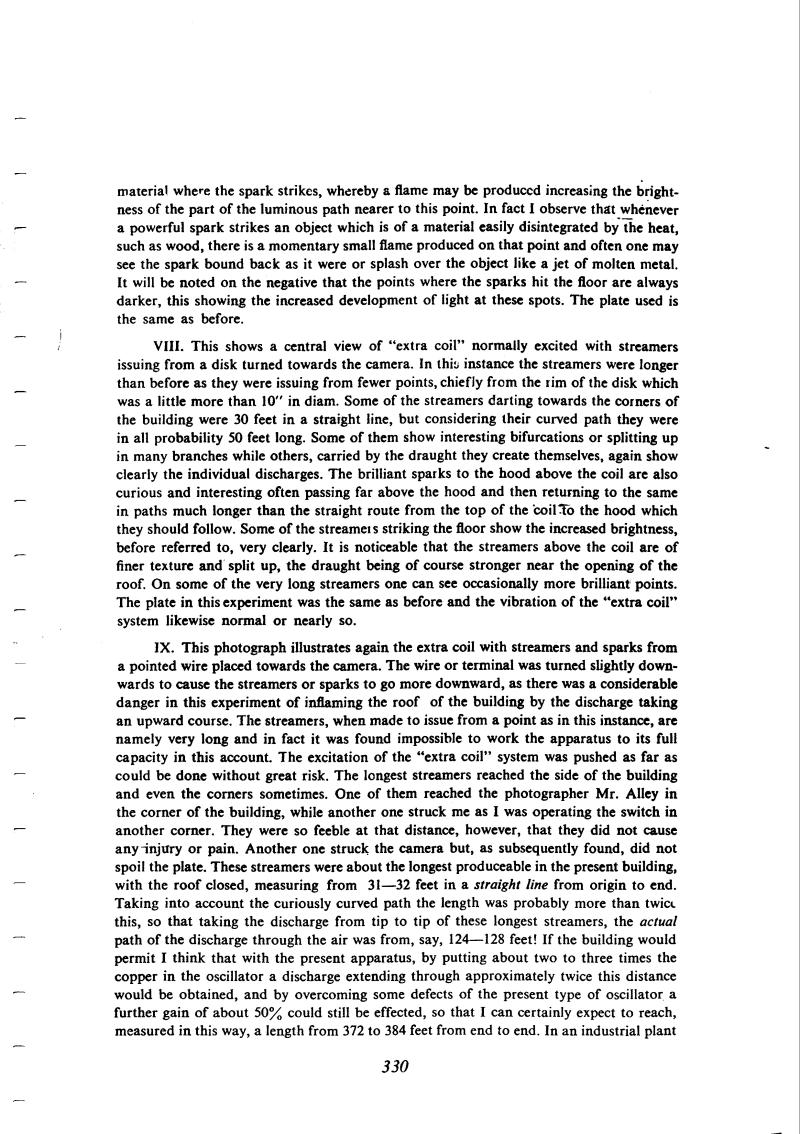
Nikola Tesla Books
material where the spark strikes, whereby a flame may be produced increasing the brightness of the part of the luminous path nearer to this point. In fact I observe that whenever a powerful spark strikes an object which is of a material easily disintegrated by the heat, such as wood, there is a momentary small flame produced on that point and often one may see the spark bound back as it were or splash over the object like a jet of molten metal. It will be noted on the negative that the points where the sparks hit the floor are always darker, this showing the increased development of light at these spots. The plate used is the same as before.
VIII. This shows a central view of âextra coilâ normally excited with streamers issuing from a disk turned towards the camera. In this instance the streamers were longer than before as they were issuing from fewer points, chiefly from the rim of the disk which was a little more than 10" in diam. Some of the streamers darting towards the corners of the building were 30 feet in a straight line, but considering their curved path they were in all probability 50 feet long. Some of them show interesting bifurcations or splitting up in many branches while others, carried by the draught they create themselves, again show clearly the individual discharges. The brilliant sparks to the hood above the coil are also curious and interesting often passing far above the hood and then returning to the same in paths much longer than the straight route from the top of the coil to the hood which they should follow. Some of the streamers striking the floor show the increased brightness, before referred to, very clearly. It is noticeable that the streamers above the coil are of finer texture and split up, the draught being of course stronger near the opening of the roof. On some of the very long streamers one can see occasionally more brilliant points. The plate in this experiment was the same as before and the vibration of the âextra coilâ system likewise normal or nearly so.
IX. This photograph illustrates again the extra coil with streamers and sparks from a pointed wire placed towards the camera. The wire or terminal was turned slightly downwards to cause the streamers or sparks to go more downward, as there was a considerable danger in this experiment of inflaming the roof of the building by the discharge taking an upward course. The streamers, when made to issue from a point as in this instance, are namely very long and in fact it was found impossible to work the apparatus to its full capacity in this account. The excitation of the âextra coilâ system was pushed as far as could be done without great risk. The longest streamers reached the side of the building and even the corners sometimes. One of them reached the photographer Mr. Alley in the corner of the building, while another one struck me as I was operating the switch in another corner. They were so feeble at that distance, however, that they did not cause any injury or pain. Another one struck the camera but, as subsequently found, did not spoil the plate. These streamers were about the longest produceable in the present building, with the roof closed, measuring from 31 - 32 feet in a straight line from origin to end. Taking into account the curiously curved path the length was probably more than twice this, so that taking the discharge from tip to tip of these longest streamers, the actual path of the discharge through the air was from, say, 124 - 128 feet! If the building would permit I think that with the present apparatus, by putting about two to three times the copper in the oscillator a discharge extending through approximately twice this distance would be obtained, and by overcoming some defects of the present type of oscillator a further gain of about 50% could still be effected, so that I can certainly expect to reach, measured in this way, a length from 372 to 384 feet from end to end. In an industrial plant
330

